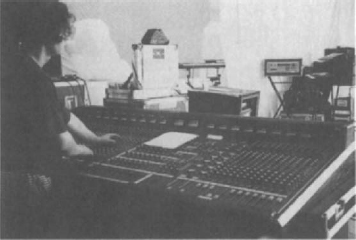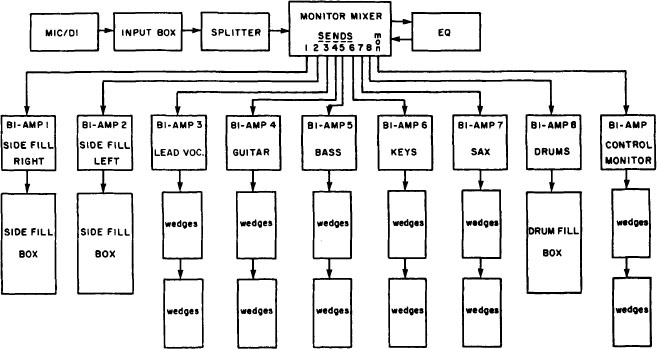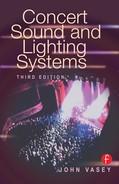CHAPTER 11
MONITOR SYSTEMS
The monitor system enables each musician to hear what the other musicians are doing. The difference between a front of house (FOH) mix and a monitor mix is that the FOH mix usually is a stereo output to the left and right speaker stacks and the monitor mix is customized for each musician. The monitor mix provides information that allows each musician to stay in time and in tune. Sometimes, however, musicians become carried away with their monitor requirements and end up wanting a fully mixed version of the group with their own contribution the loudest.
Monitor mixing is much more complex than FOH mixing, because each mix output must be individually mixed and listened to on its own at the side of the stage. This can be confusing because it may sound dreadful alone but be just what is needed on stage. It is important to listen continually to the mixes and watch the musicians closely. The monitor operator is the person on whom the group depends to combine all the individual efforts on stage into a complementary whole. The monitor operator must walk around the stage at sound checks and listen to how each mix contributes to overall sound.
MONITOR CONSOLES 
Monitor consoles (Figure 11–1) differ from house mixing consoles in number of outputs. A monitor console may have up to 16 outputs, each channel having a level control for each output. A 32 into 12 console has 32 input channels and 12 outputs. Graphic equalizers (Figure 11–2) are inserted across the outputs to equalize each cabinet driven by each mix. The graphics are inserted rather than patched in the chain so that the monitor operator hears what is coming from the speaker after it has been equalized. It is important to know exactly which outputs are close to feedback, so they can be quickly adjusted if feedback starts. There is nothing more annoying when listening to or performing music to hear feedback screeching through the speakers.

Figure 11–1. Monitor console. These consoles differ from house mixing consoles in their number of outputs. (Courtesy Yamaha Music.)
Tuning the monitor system depends on the position and musical content of the monitor speaker. A wedge monitor with only vocals can have the lower frequencies rolled off to reduce the amount of rumble. A monitor cabinet for a drummer requires fatter sound with a different sort of tuning. Do not over-equalize and end up hacking the sound to pieces. Of course you will hear feedback if you cover the end of the microphone or point it into the cabinet, but that does not happen during a performance. Always discuss a monitor mix with the musicians before plowing into it. No matter the level at which you start, musicians invariably want more, not less, which leaves you no headroom and on the brink of feedback. Musicians sometimes must compromise (for example, the singers need more vocal so the guitar player must make do with less), so the monitor operator must use tact in suggesting necessary changes.

Figure 11–2. Equalizer rack. Graphic equalizers are inserted across each output to equalize each cabinet driven by each mix.
MONITOR SPEAKERS 
The main type of monitor cabinet is the wedge monitor, so called because it is wedge shaped. Wedges may contain a number of different components, such as two 12-inch speakers and a compression driver and one 15-inch speaker and a compression driver, or vice versa. These cabinets can be run with passive crossovers or biamplified and run two-way. The crossover point is related to the type of component. Side-fill cabinets placed on either side of the stage are more substantial than wedges. Drum and keyboard monitor cabinets usually must handle more power and lower frequencies than wedges can handle.
IN-EAR MONITORS 
The use of in-ear monitoring systems is becoming more common. They allow consistent monitoring night after night, no matter what the situation. In-ear monitors are not a cure-all for monitoring woes. They present a new series of challenges for monitor engineers. Ear monitors can reduce ear fatigue by reducing exposure to excessive levels, but they can be dangerous if not properly protected. Brick wall limiting should be used to provide protection from unexpected feedback from on-stage wedges or electronic failures. In-ear monitors give the engineer greater control of the sound mix and better sound quality, and they decrease risk for feedback. The performer has greater freedom of movement and reduced ear and vocal fatigue.
MIX CONTENTS 
Each monitor mix depends on the musicians, their music, and the size of the stage. A monitor system schematic is shown in Figure 11–3. An eight-send monitor system for a group of musicians consisting of drummer, keyboard player, saxophone player, guitarist, bass player, and lead vocalist would typically consist of the following:
Mix 1: Side-fill stage right. This mix would have a general balance of drums, vocals, and possibly some instruments.
Mix 2: Side-fill stage left. This mix is similar to mix 1.
Mix 3: Lead vocalist. A pair of wedges for the lead vocalist would contain the lead vocal, snare drum, and melody instrument.
Mix 4: Guitar player. This mix would contain only the guitar player's vocal, and most of the information required would come through the side fill.
Mix 5: Bass player. This mix would contain only the bass player's vocal, and most of the information would come through the side fill.
Mix 6: Keyboard player. The keyboard player would need snare, vocals, and other instruments.
Mix 7: Saxophone player. The saxophone player would need the saxophone and other instruments depending on his or her position on stage.
Mix 8: Drums. The drum monitor would contain the drums, bass guitar, and vocals.

Figure 11–3. Schematic of monitor system.
